Brake Caliper Replacement Front-Single Piston
Removal Procedure
Important: Refer to
Disc Brakes System Description
.
- Remove two-thirds of the brake fluid from the master cylinder
reservoir.
- Raise the vehicle and support the vehicle with proper safety stands.
Refer to
Lifting and Jacking the Vehicle
in General Information.
- Remove the tire and wheel assembly. Refer to
Wheel Removal
in Tires and Wheels.
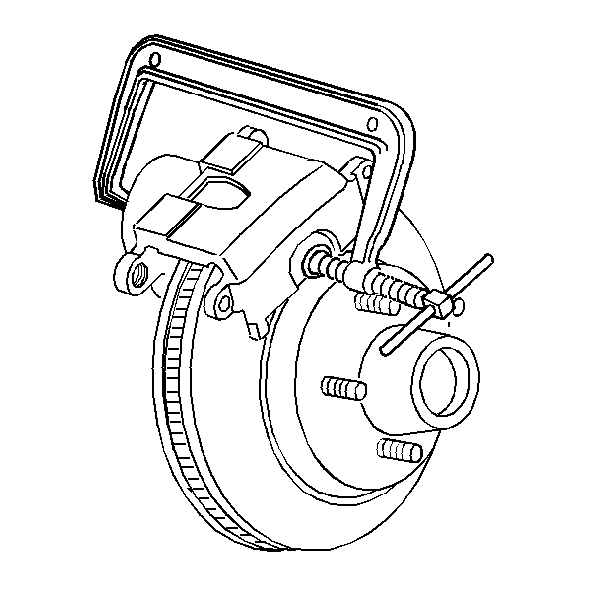
- Position a C-clamp over
the outer brake pad and the caliper.
| 4.1. | Tighten the C-clamp until the piston bottoms in the caliper bore. |
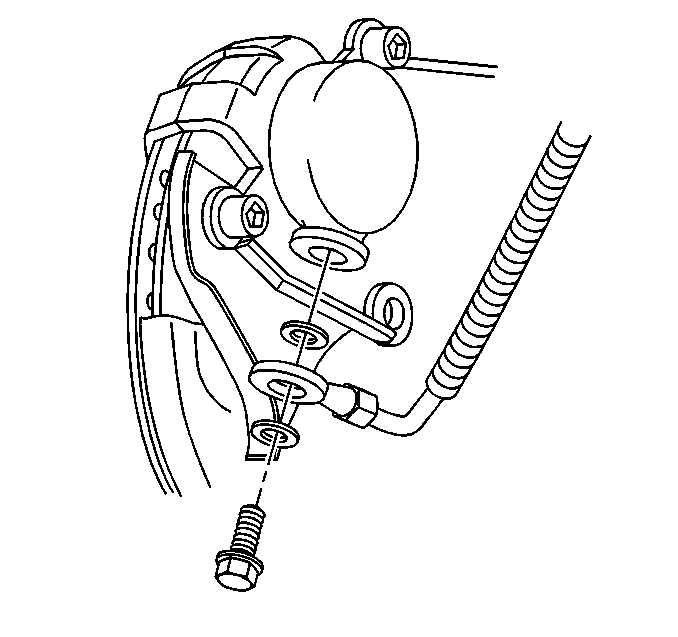
- Disconnect the brake hose
from the caliper.
| 5.1. | Disconnect the brake hose fitting and the two gaskets. |
| 5.2. | Discard the gaskets. |
| 5.3. | Plug the hole in the caliper housing and in the brake hose fitting. |
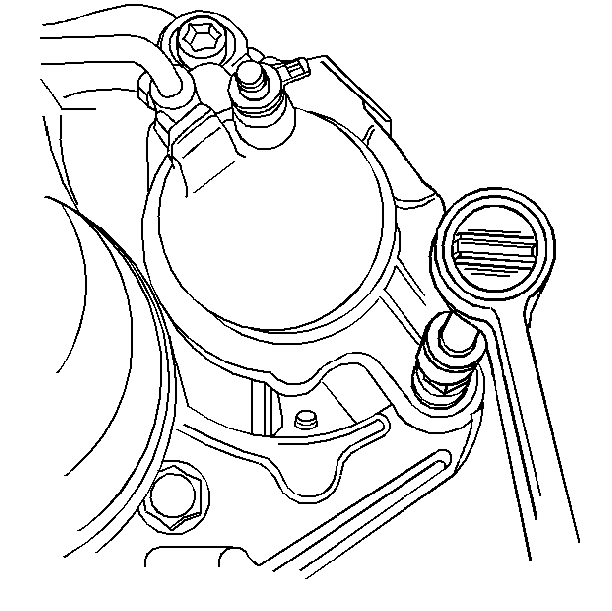
- Remove the caliper mounting
bolts.
- Remove the caliper.
- Remove the brake linings from the caliper. Refer to
Front Disc Brake Pads Replacement
.
- Remove the mounting bolt sleeves.
- Remove the rubber O-ring bushings. Discard the bushings.
Inspection Procedure
- Inspect the mounting bolts and sleeves for corrosion. Do not
polish away any corrosion.
Replace the corroded mounting bolts and sleeves.
- Inspect the brake hose fitting bolt. If the through-hole is blocked,
remove the blockage or replace the bolt.
- Inspect the linings for wear. Replace as necessary. Refer to
Brake Pad Inspection
.
- Inspect the caliper. Refer to
Brake Caliper Inspection
.
Installation Procedure
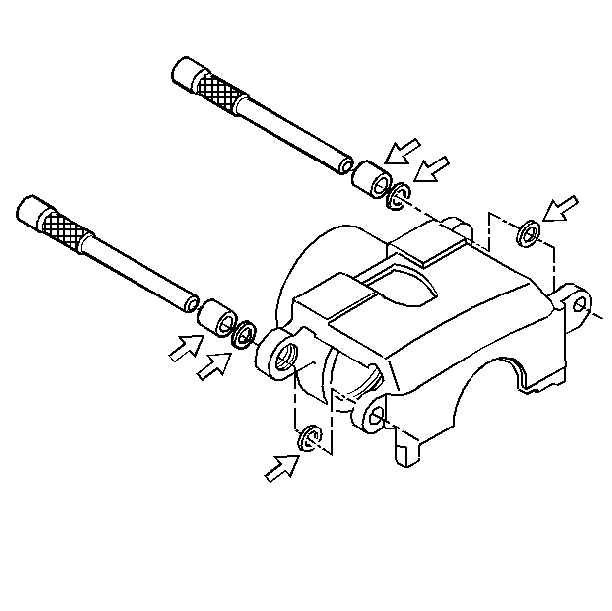
Caution: Do not move the vehicle until a firm brake pedal is obtained. Failure
to obtain a firm pedal before moving vehicle may result in personal injury.
- Lubricate the sleeves and the new bushings with Delco Silicone Lube
(GM P/N 18010909) or equivalent.
- Install the new rubber O-ring bushings to the caliper.
- Install the mounting bolt sleeves.
Important: Lift the inner edge caliper boot next to the piston. Press out any trapped
air. The boot must lay flat below the level of the piston face.
- Install the brake linings to the caliper. Refer to
Front Disc Brake Pads Replacement
.

Notice: Use the correct fastener in the correct location. Replacement fasteners
must be the correct part number for that application. Fasteners requiring
replacement or fasteners requiring the use of thread locking compound or sealant
are identified in the service procedure. Do not use paints, lubricants, or
corrosion inhibitors on fasteners or fastener joint surfaces unless specified.
These coatings affect fastener torque and joint clamping force and may damage
the fastener. Use the correct tightening sequence and specifications when
installing fasteners in order to avoid damage to parts and systems.
- Install the caliper
and the two mounting bolts.
Tighten
Tighten the mounting bolts to 51 N·m (38 lb ft).
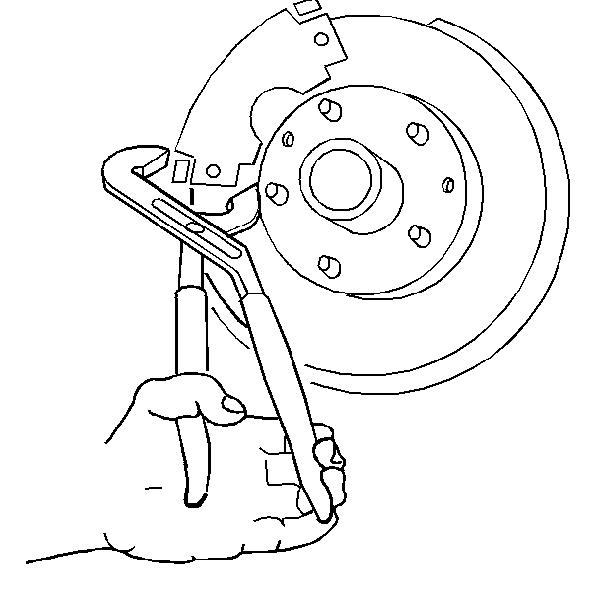
- Compress the lining ears
to the caliper.

Notice: Make sure the brake hose is not twisted or kinked after
installation. Damage to the hose could result.
- Install the following components:
| • | The brake hose fitting bolt |
Tighten
Tighten the brake hose bolt to 54 N·m (40 lb ft).

Important: If necessary, remove the front brake caliper and file the ends of the
steering knuckle to obtain the proper clearance. If the total clearance exceeds
the specified range, check the steering knuckle and front brake caliper
for damage and replace as necessary.
- Measure the clearance between the caliper and the steering knuckle.
| 8.1. | Measure each end of the caliper individually. |
| 8.2. | Add the two measurements together. The total measurement should
be 0.26-0.60 mm (0.010-0.024 in). |
- Bleed the caliper. Refer to
Hydraulic Brake System Bleeding
in Hydraulic Brakes.
- Install the tire and wheel assembly. Refer to
Wheel Installation
in Tires and Wheels.
- Remove the safety stands and lower the vehicle.
- With the engine running, firmly pump the brake pedal 3 times.
- Inspect the brake system for leaks.
Brake Caliper Replacement Rear
Important: Refer to
Disc Brakes System Description
.
Removal Procedure
- Remove two-thirds of the brake fluid from the master cylinder
reservoir.
- Raise the vehicle and support the vehicle with proper safety stands.
Refer to
Lifting and Jacking the Vehicle
in General Information.
- Remove the tire and wheel assembly. Refer to
Wheel Removal
in Tires and Wheels.
- Position a C-clamp over the outer brake pad and the caliper.
| 4.1. | Tighten the C-clamp until the piston bottoms in the caliper bore. |
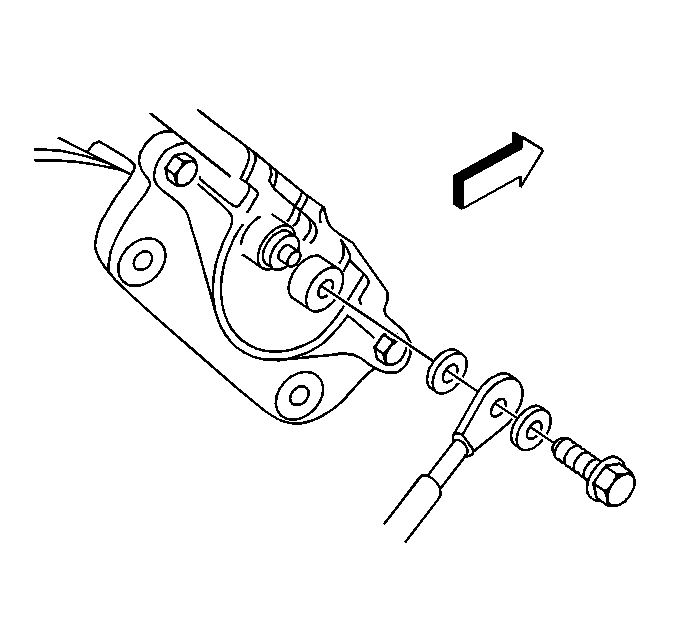
- Disconnect the brake hose
from the caliper.
| 5.1. | Disconnect the brake hose fitting and two gaskets. |
| 5.2. | Discard the gaskets. |
| 5.3. | Plug the hole in the caliper housing, and in the brake hose fitting. |
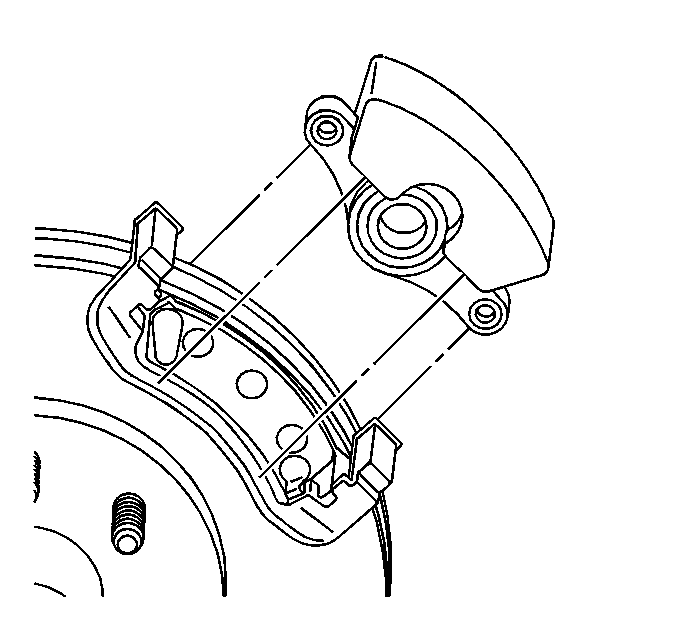
- Remove the guide pin bolts.
- Remove the caliper from the bracket.
Inspection Procedure
- Inspect the guide pin bolts and sleeves for corrosion.
Replace corroded guide pin bolts and sleeves.
- Inspect the brake hose fitting bolt. If the through-hole
is blocked, remove the blockage or replace the bolt.
- Inspect the linings for wear. Replace as necessary. Refer to
Brake Pad Inspection
.
- Inspect the caliper. Refer to
Brake Caliper Inspection
.
Installation Procedure
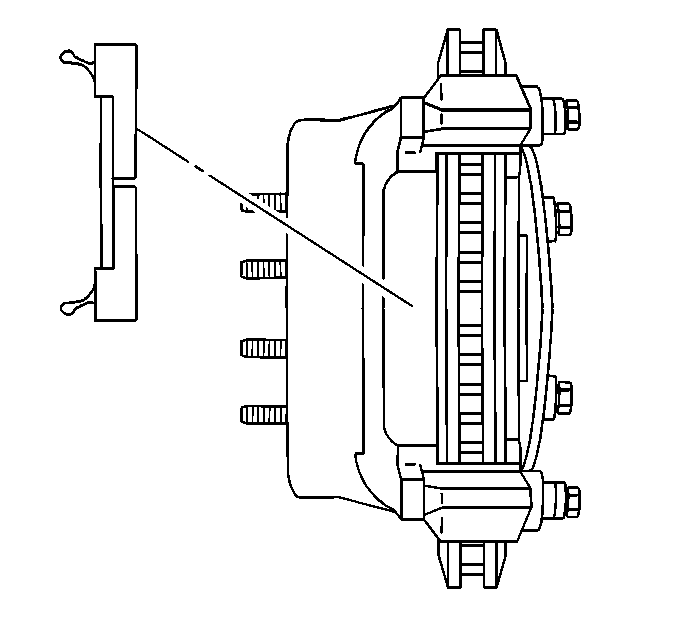
Caution: Do not move the vehicle until a firm brake pedal is obtained. Failure
to obtain a firm pedal before moving vehicle may result in personal injury.
- Verify that the linings are in position.

Important: Lift the inner edge caliper boot next to the piston. Press out any trapped
air. The boot must lay flat below the level of the piston face.
- Install the caliper over the rotor and into the anchor bracket.
- Lubricate the guide pin bolts with Delco Silicone Lube (GM P/N 18010909)
or equivalent.
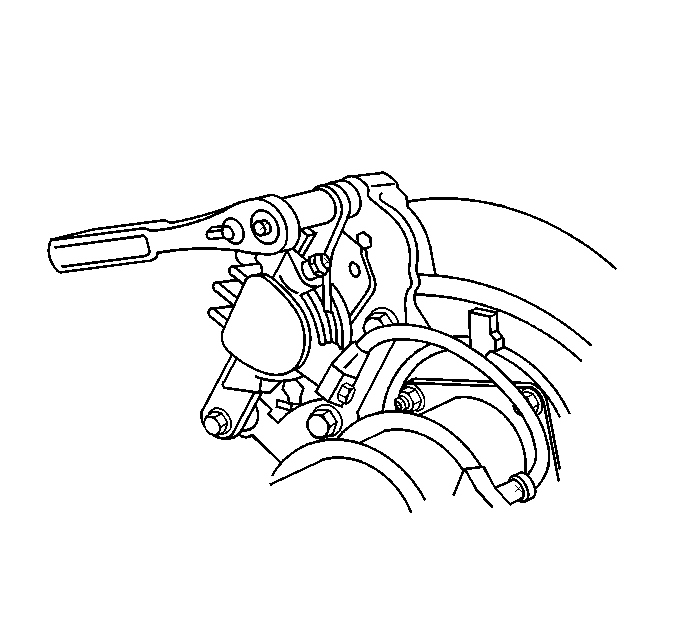
Notice: Use the correct fastener in the correct location. Replacement fasteners
must be the correct part number for that application. Fasteners requiring
replacement or fasteners requiring the use of thread locking compound or sealant
are identified in the service procedure. Do not use paints, lubricants, or
corrosion inhibitors on fasteners or fastener joint surfaces unless specified.
These coatings affect fastener torque and joint clamping force and may damage
the fastener. Use the correct tightening sequence and specifications when
installing fasteners in order to avoid damage to parts and systems.
- Install the two
caliper guide pin bolts to the caliper bracket.
Tighten
Tighten the bolt to 31 N·m (23 lb ft).
Notice: Make sure the brake hose is not twisted or kinked after
installation. Damage to the hose could result.

- Install the following
components:
| • | The brake hose fitting bolt |
Tighten
Tighten the brake hose bolt to 54 N·m (40 lb ft).
- Bleed the caliper. Refer to
Hydraulic Brake System Bleeding
in Hydraulic Brakes.
- Install the tire and wheel assembly. Refer to
Wheel Removal
in Tires and Wheels.
- Remove the safety stands and lower the vehicle.
- With the engine running, firmly pump the brake pedal three times.
- Check the brake system for leaks.
Brake Caliper Replacement Front-Dual Piston
Removal Procedure
Important: Refer to
Disc Brakes System Description
.
- Remove two-thirds of the brake fluid from the master cylinder
reservoir.
- Raise the vehicle and support the vehicle with proper safety stands.
Refer to
Lifting and Jacking the Vehicle
in General Information.
- Remove the tire and wheel assembly. Refer to
Wheel Removal
in Tires and Wheels.

- Position a C-clamp over
the outer brake pad and the caliper.
| 4.1. | Tighten the C-clamp until the piston bottoms in the caliper bore. |

- Disconnect the brake hose
from the caliper.
| 5.1. | Disconnect the brake hose fitting and two gaskets. |
| 5.2. | Discard the gaskets. |
| 5.3. | Plug the hole in the caliper housing and in the brake hose fitting. |

- Remove the caliper guide
pin bolts.
- Remove the caliper from the caliper bracket.
Inspection Procedure
- Inspect the caliper guide pin bolts for corrosion. Do not polish
away any corrosion.
Replace corroded bolts.
- Inspect the brake hose fitting bolt. If the through-hole is blocked,
remove the blockage or replace the bolt.
- Inspect the linings for wear. Replace as necessary. Refer to
Brake Pad Inspection
.
- Inspect the caliper. Refer to
Brake Caliper Inspection
.
Installation Procedure

Caution: Do not move the vehicle until a firm brake pedal is obtained. Failure
to obtain a firm pedal before moving vehicle may result in personal injury.
- Verify that the linings are in position.
Important: Lift the inner edge of the caliper boots next to the pistons. Press
out any trapped air. The boots must lay flat below the level of the piston
faces.
- Install the caliper over the rotor and into the anchor bracket.
- Lubricate the guide pin bolts with Delco Silicone Lube (GM P/N 18010909)
or equivalent.

Notice: Use the correct fastener in the correct location. Replacement fasteners
must be the correct part number for that application. Fasteners requiring
replacement or fasteners requiring the use of thread locking compound or sealant
are identified in the service procedure. Do not use paints, lubricants, or
corrosion inhibitors on fasteners or fastener joint surfaces unless specified.
These coatings affect fastener torque and joint clamping force and may damage
the fastener. Use the correct tightening sequence and specifications when
installing fasteners in order to avoid damage to parts and systems.
- Install the two
caliper guide pin bolts to the caliper bracket.
Tighten
Tighten the bolts to 115 N·m (85 lb ft).

Notice: Make sure the brake hose is not twisted or kinked after
installation. Damage to the hose could result.
- Install the following components:
| • | The brake hose fitting bolt |
Tighten
Tighten the brake hose bolt to 54 N·m (40 lb ft).
- Bleed the caliper. Refer to
Hydraulic Brake System Bleeding
in Hydraulic Brakes.
- Install the tire and wheel assembly. Refer to
Wheel Installation
in Tires and Wheels.
- Remove the safety stands and lower the vehicle.
- With the engine running, firmly pump the brake pedal 3 times.
- Check the brake system for leaks.




















